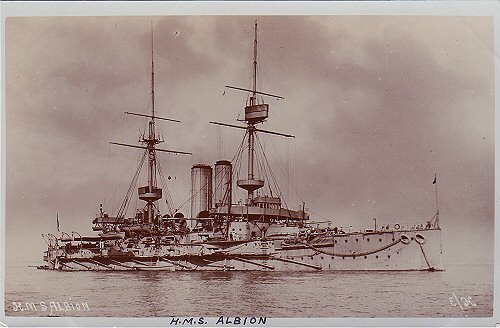
Sold for Scrap 11 December 1919
HMS Albion was laid down by Thames Iron Works at Blackwall on 3 December 1896. Tragedy struck when she was launched on 21 June 1898; after the Duchess of York christened her, a wave created by Albion's entry into the water caused a stage from which 200 people were watching to collapse into a side creek, and 34 people, mostly women and children, drowned. Albion's completion then was delayed by late delivery of her machinery. She finally began trials late in 1900, during which she was further delayed by machinery and gun defects, and she was not finally completed until June 1901.
Albion was designed for service in the Far East, and to be able to transit the Suez Canal. She was designed to be smaller (by about 2,000 tons), lighter, and faster than her predecessors, the Majestic-class battleships, although she was slightly longer at 430 feet (131 meters). In order to save weight, she carried less armor than the Majestics, although the change from Harvey armor in the Majestics to Krupp armor in Albion meant that the loss in protection was not as great as it might have been, Krupp armor having greater protective value at a given weight than its Harvey equivalent. Still, her armor was light enough to make her almost a second-class battleship.
HMS Albion commissioned on 25 June 1901 at Chatham Dockyard to relieve battleship Barfleur on the China Station. On 9 September 1901, she relieved Barfleur as second flagship of the China Station at Hong Kong. During her time on the station, she underwent refits at Hong Kong in 1902 and 1905.
When World War I broke out in August 1914, Albion was assigned to the 8th Battle Squadron, Channel Fleet. On 15 August 1914, she became second flagship of the new 7th Battle Squadron. On 21 August 1914, she was sent to the Saint Vincent-Finisterre Station to provide battleship support to cruiser squadrons operating in the Atlantic in case German Navy heavy ships broke out into the open Atlantic. On 3 September 1914, she transferred her flag, becoming a private ship, and moved to the Cape Verde-Canary Islands station on to relieve her sister ship Canopus there.
On 4 October 1915, Albion arrived at Salonika to become a unit of the 3rd Detached Squadron, tasked with assisting the French Navy in a blockade of the coasts of Greece and Bulgaria and with reinforcing the Suez Canal Patrol. She embarked the first British Army contingent of 1,500 troops for Salonika and escorted French troopships carrying the French second contingent.
Albion served on the Salonika Station until April 1916, then became a guard ship at Queenstown, Ireland, later that month. In May 1916 she moved to Devonport for a refit; that completed, she moved on to the Humber in August 1916 for service as a guard ship there.
In October 1918, Albion's service as a guard ship came to an end, and she was reduced to service as an accommodation ship. In August 1919, she was placed on the disposal list at Devonport. She was sold for scrapping on 11 December 1919. She left Devonport under her own steam on 3 January 1920, arriving at Morecambe for scrapping on 6 January 1920.